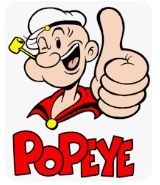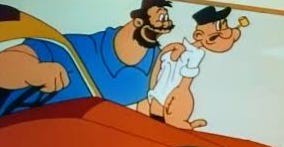A Brief History
Popeye, the Sailor Man, is a fictional cartoon character created by Elzie Crisler Segar in the late 1920s and first appeared on January 17, 1929, in the comic strip Thimble Theatre. The sailor quickly became popular and was the comic's main feature and one of the most popular properties during the 1930s. Following Segar's death in 1938, he was formally named Popeye.
In 1933, theatrical cartoon shorts for Paramount Pictures were created. These cartoons were amongst the most popular of the 1930s and were made until 1957. Cartoons produced during World War II included allied propaganda, common among comic characters then.
Over the years, Popeye has appeared in comic books, television cartoons, video games and hundreds of advertisements, ranging from spinach to candy cigarettes, and the 1980 live-action film starring Robin Williams as Popeye.
In 2002, TV Guide ranked Popeye number 20 on its "50 Greatest Cartoon Characters of All Time" list.
In his original storyline, Popeye's superhuman strength and endurance came from rubbing the feathers of Bernice, a "whiffle hen", enabling him to survive fifteen gunshot wounds. By the end of 1929, Popeye's strength had become a regular fixture of his character, with spinach, by 1932, becoming his source of power. From then on, spinach would come to his rescue whenever he was in a hopeless situation, increasing spinach sales in the US by over 30%.
In animated cartoons, Popeye’s pipe proves to be very versatile. It has served as a cutting torch, propeller, periscope, musical instrument, and whistle for him to produce his trademark toot. He also eats spinach through his pipe, sometimes sucking in the can and the contents. Since the 1970s, Popeye rarely used his pipe to smoke tobacco.
Throughout his history, Popeye has suffered from inconsistencies in the storylines, with the only consistent plot being the love triangle between Popeye, Olive Oyls, and Bluto (often called Brutus), and Bluto's endless attempts to claim Olive at Popeye's expense.
In January 2019, to celebrate Popeye's 90th Anniversary, a webcomic Popeye's Cartoon Club was launched with a wide range of artists depicting the characters in their style.
The original television cartoons started in 1960 and continued for the next four decades, being updated as cultural changes happened.
In 2001, Cartoon Network created a new version of The Popeye Show, running until 2004. Since then, both restored, and original versions have been released on DVD for all generations to enjoy.
Characters
Popeye:
The iconic sailor with bulging forearms, a pipe, and an unwavering sense of justice. Popeye's spinach-powered punches make him a formidable foe for any villain, always standing up for the underdog and defending the weak. His distinctive voice, kind heart, and determination make him a beloved high-seas hero.
J. Wellington Wimpy:
A portly and cunning connoisseur of hamburgers, Wimpy's catchphrase "I'll gladly pay you Tuesday for a hamburger today" has become legendary. Despite his love for food and laziness, he occasionally surprises with acts of loyalty and resourcefulness.
Olive Oyl:
Popeye's tall and slender sweetheart, Olive Oyl, is a charming, albeit somewhat clumsy, woman. Her loyalty to Popeye and compassion for others often lead her into adventurous situations, adding to the excitement.
Swee'Pea and Jeep:
Swee'Pea is Popeye's adorable, nappy-wearing adopted son with mysterious origins. Jeep, the magical "Eugene the Jeep," is a small creature with the ability to teleport, adding a touch of enchantment to the gang's escapades.
Bluto:
Popeye's muscular nemesis and a constant thorn in his side. Bluto's brute strength and jealousy over Olive Oyl often drive him into confrontations with our hero. Despite being a villain, Bluto occasionally shows glimpses of vulnerability and inner conflict.
Fun Facts
Spinach sales grew by over 30% when Popeye started showing in cinemas.
Real-Life Inspiration: Popeye's distinctive voice was inspired by the legendary performer William "Billy" Costello. He provided the voice for Popeye in the early cartoons, shaping the character's unique speech patterns.
Robin Williams played him in the 1980 live-action film version.
Culture Corner “I yam, what I yam.”
As a fictional character, Popeye has had to evolve in response to various factors, including changes in societal norms and values, but also due to the evolution of storytelling and audience preferences. When Popeye was first created in the 1920s, his portrayal and the themes of the cartoons were influenced by the cultural context of that era.
Initially, Popeye was a scrappy, no-nonsense character known for his rough-and-tumble demeanour. He often engaged in physical confrontations, and the cartoons sometimes depicted exaggerated stereotypes that were prevalent in those times. As societal attitudes shifted and evolved, certain aspects of the character were toned down or adjusted to be more in line with changing sensitivities.
One significant example is the portrayal of racial and ethnic stereotypes. Early Popeye cartoons featured characters that embodied racial caricatures, reflecting the unfortunate racism during that time. As society became more aware of the harm caused by such representations, these offensive elements were gradually phased out in later adaptations of Popeye.
While Popeye has changed over the years to align with evolving societal norms and storytelling conventions, his core traits and values as a spinach-loving, justice-seeking sailor have remained relatively consistent, making him a timeless and enduring character.
Merchandise & Spin-offs
Other than the comics and cartoons, the world of Popeye has had an impact further afield.
Popeye Village in Malta, built for the film, is still a popular tourist destination.
In the early part of Popeye’s Carnation, he was featured on several different radio shows, and as time passed, he has featured in pinball and video games too.
Wimpy's name was borrowed for the Wimpy Restaurant chain, one of the first international fast food restaurants featuring hamburgers, which they call "Wimpy Burgers".
The popular fast-food chain Popeyes is the second-largest "quick-service chicken restaurant group" behind Kentucky Fried Chicken. It was not named for the sailor. However, Popeye has been featured in commercials.







It’s so funny that spinach sales went up after this cartoon aired! Great overview, thank you for sharing :)
I loved Popeye and Olive Oyl and remember as a kid the first time I had spinach, thinking it was going to make me strong...